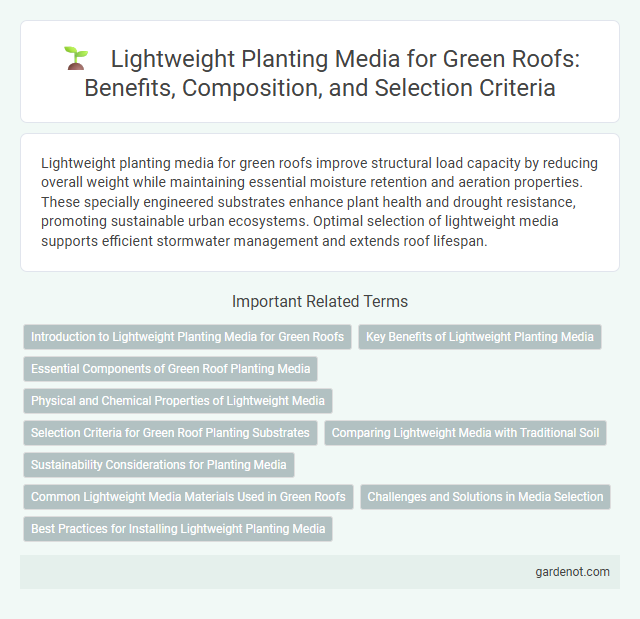Lightweight planting media for green roofs improve structural load capacity by reducing overall weight while maintaining essential moisture retention and aeration properties. These specially engineered substrates enhance plant health and drought resistance, promoting sustainable urban ecosystems. Optimal selection of lightweight media supports efficient stormwater management and extends roof lifespan.
Introduction to Lightweight Planting Media for Green Roofs
Lightweight planting media for green roofs consist of specially engineered substrates designed to reduce structural load while supporting healthy plant growth. These media typically combine expanded clay, perlite, and organic matter, optimizing water retention, aeration, and nutrient availability. Their reduced weight improves roof stability and extends the lifespan of green roofing systems, making them essential for urban applications.
Key Benefits of Lightweight Planting Media
Lightweight planting media significantly reduce the structural load on green roofs, enabling installation on a wider range of buildings, including those with limited load-bearing capacity. They enhance drainage and aeration, promoting healthier root development and improving plant resilience in varied weather conditions. The use of lightweight media also simplifies installation and maintenance processes, lowering overall costs and extending the lifespan of green roof systems.
Essential Components of Green Roof Planting Media
Lightweight planting media for green roofs consist primarily of inorganic materials such as expanded clay, perlite, or pumice combined with organic matter like compost to ensure adequate drainage, aeration, and water retention. Essential components include mineral aggregates that provide structural stability and porosity, organic content for nutrient supply, and a balanced pH to support diverse vegetation growth while minimizing substrate weight. Optimizing these elements enhances plant health, reduces roof load, and improves stormwater management efficiency.
Physical and Chemical Properties of Lightweight Media
Lightweight planting media for green roofs exhibit high porosity and low bulk density, enhancing drainage and reducing structural load on buildings. Chemically, these media maintain a balanced pH range and nutrient-holding capacity to support healthy plant growth while minimizing the risk of toxic element accumulation. The combination of physical stability and optimal chemical properties ensures efficient water retention, aeration, and nutrient availability in extensive green roof systems.
Selection Criteria for Green Roof Planting Substrates
Lightweight planting media for green roofs must prioritize criteria such as low bulk density, high water retention capacity, and adequate nutrient availability to ensure plant health and structural safety. Substrates should exhibit excellent drainage properties combined with sufficient aeration to prevent root waterlogging while supporting diverse plant species adapted to rooftop conditions. Selecting materials like expanded clay, pumice, or engineered foams balances weight reduction with durability, enhancing long-term performance and stormwater management on extensive green roofs.
Comparing Lightweight Media with Traditional Soil
Lightweight planting media for green roofs significantly reduces structural load by weighing 30-50% less than traditional soil, enhancing building safety and enabling installation on a wider range of structures. These engineered substrates optimize water retention and nutrient availability while promoting root aeration, resulting in healthier vegetation and improved stormwater management. Compared to conventional soil, lightweight media demonstrates superior drainage capacity, reducing the risk of waterlogging and root damage in extensive green roof systems.
Sustainability Considerations for Planting Media
Lightweight planting media for green roofs prioritize sustainability by incorporating recycled materials such as expanded clay, perlite, and organic compost to reduce environmental impact and enhance resource efficiency. These substrates support water retention and nutrient availability while minimizing structural load on buildings, promoting energy savings and biodiversity. Optimizing media composition enhances stormwater management and urban heat island mitigation, crucial for resilient green infrastructure.
Common Lightweight Media Materials Used in Green Roofs
Common lightweight planting media used in green roofs include expanded shale, clay, and slate, which provide excellent drainage and aeration while reducing overall substrate weight. Perlite and vermiculite are also frequently incorporated to enhance moisture retention and improve soil structure without adding significant mass. These materials create an optimal environment for vegetation growth, ensuring durability and performance in extensive and intensive green roof systems.
Challenges and Solutions in Media Selection
Lightweight planting media for green roofs face challenges such as maintaining adequate water retention, providing sufficient nutrient supply, and ensuring structural stability under varying weather conditions. Selecting media with optimized porosity and organic matter content helps balance water retention and drainage, while incorporating lightweight aggregates like expanded clay or perlite reduces overall substrate weight without compromising root support. Advances in engineered substrates combining mineral granules and biochar address nutrient retention issues and improve plant health, offering effective solutions for sustainable green roof performance.
Best Practices for Installing Lightweight Planting Media
Lightweight planting media for green roofs should be carefully engineered to balance drainage, nutrient retention, and support for vegetation while minimizing overall system weight. Best practices include selecting substrates with inorganic components like expanded shale or clay to enhance aeration and water retention, ensuring proper layering to prevent compaction and maintain root health. Installing lightweight media with consistent particle size distribution and integrating organic matter can optimize plant growth and improve the green roof's long-term structural performance.
Lightweight planting media Infographic

 gardenot.com
gardenot.com